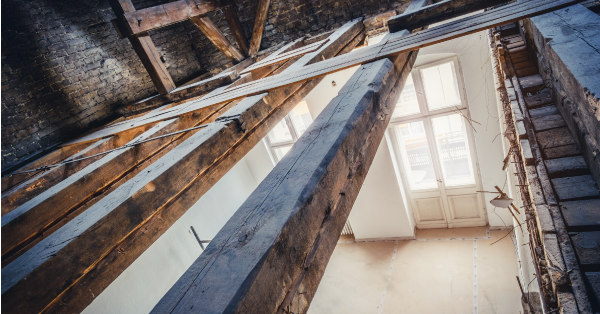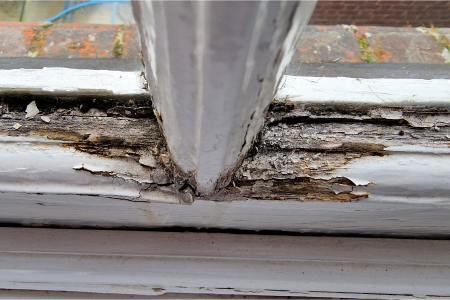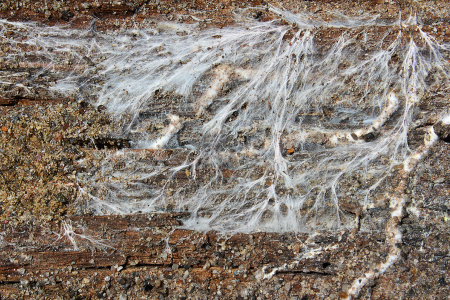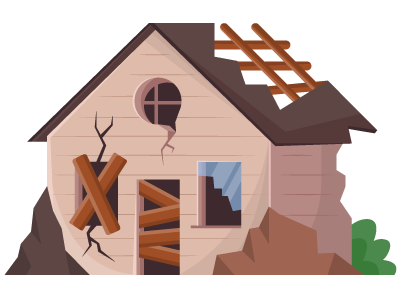Wet and Dry Rot Treatment
- Dry rot can end up more damaging than wet rot, and is also harder to detect and control.
- Top Tip: Get a Damp and Timber survey from us as soon as possible to avoid potential future costly repairs. Your mortgage lender might even require it if it's highlighted in your valuation report.
- Wet rot can be treated more effectively than dry rot. The key to both is eliminating the source of the moisture, but in most dry rot cases a specialist will be required.
Wood rot can be a nightmare for homeowners and property investors alike. Dry and wet rot are two major causes of timber decay in both old and modern buildings. They are caused by wood-destroying fungus, which leads to fungal decay and spreads by millions of airborne spores.
Due to the devastating damage, this defect can cause and the costs involved in eradicating it, home buyers are well advised to get a thorough inspection from a RICS surveyor to highlight any of its signs within their property. Understanding the differences between wet and dry rot, and knowing how to treat them, is essential for maintaining the integrity of your property.
Treating wood rot
Treating dry rot is a serious issue that can affect the structural integrity of your property. The two main types of wood rot are wet and dry rot, both caused by fungal decay. Here’s a closer look at what they are and how to fix them.
Is wet rot worse than dry rot?
When it comes to timber decay, understanding the differences between wet rot and dry rot is important.
Dry rot spores play a crucial role in the development of dry rot, as they require damp timber with a moisture content of over 20% and lack of ventilation to grow and cause infestation. Both wood rot types can cause significant damage, but they vary in severity, spread, and treatment methods.
Are you buying a home with suspected rot?
Our expert RICS-accredited surveyors will be able to detect the rooms most affected and provide a detailed report for you.
Dry rot is not only more damaging than wet rot but also harder to detect and control. Its ability to spread through non-wood materials and affect large areas makes it a significant concern for homeowners.

What is wet rot?
Wet rot occurs more often than dry rot but is generally less serious. It typically only causes decay where timber has become and remains wet. Wet rot fungus attacks timber and strips out the darker colours, giving the timber a soft spongy feel.
It thrives in environments where the moisture content in the wood exceeds 20%. Common areas prone to wet rot include basements, bathrooms, kitchens, and any place where timber is in contact with damp masonry. Wet rot weakens the structural integrity of the wood, leading to potential safety hazards over time.
Unlike dry rot, wet rot tends to stay confined to the damp area where it originated. However, the presence of wet rot often indicates broader moisture issues in the property, which can lead to other forms of decay and damp problems. Identifying and addressing the underlying moisture source is crucial to prevent recurrence and further damage.
Wet rot is often confused with general damp, but they are not the same. Damp is simply the presence of moisture in your property, while wet rot specifically refers to the decay of timber caused by fungal growth in damp conditions.
Wet rot causes
- Leaking roofs and gutters.
- Poorly sealed windows and doors.
- Plumbing leaks.
- Condensation from inadequate ventilation.
- High humidity.
Types of wet rot
The most common type of fungus causing wet rot in the UK is Coniophora puteana, also known as the cellar fungus. Other fungi include Phellinus contiguous and Donkioporia expanse.




Identifying wet rot
- Timber that appears darker than surrounding areas.
- A soft and spongy texture in affected wood.
- Cracked or crumbling wood.
- Visible wet rot fungus growth, often black or brown.
- A damp, musty smell.
Wet rot treatment - can wet rot be fixed?
Wet rot can be treated effectively. The key is to eliminate the source of moisture, replace the affected timber, and treat the remaining wood with a fungicide.
- Fix the source of damp so that timber moisture is kept to a safe level, below 20%.
- Any weakened wood is removed.
- The remaining timber which might be at risk is treated with fungicide.
- Preservative-treated wood is used to replace all removed timber.
- A wet rot wood hardener can be applied to strengthen and repair wood affected by wet rot. This involves removing crumbling wood, drilling holes for deeper penetration, and using a paintbrush to apply the hardener.
- Proper ventilation and moisture prevention are crucial to avoid future occurrences.
What is dry rot?
Dry rot is more serious than wet rot and can spread through a property, causing significant structural damage. Applying wood rot treatment is essential in preventing dry rot, as it helps treat timber and prevent future outbreaks.
Dry rot thrives in conditions where there is moisture, but once established, it can spread through dry areas by drawing moisture from the wood itself.
This fungus can penetrate through masonry, plaster, and even behind finishes, making it difficult to detect until significant damage has occurred. It’s often found in concealed areas such as behind walls, under floors, and in roof spaces.
Dry rot causes
Dry rot is caused by the fungus serpula lacrymans , the most serious form of fungal decay in a building. This dry rot fungus spreads from damp, poorly ventilated conditions, often starting in areas where moisture is present but then spreading to drier parts of the timber. Unlike wet rot, dry rot can spread beyond the initial damp area, making it particularly destructive.




Common signs of dry rot
- Distinct mushroom smell.
- A white, cotton-wool-like growth on the timber.
- Yellow or lilac tinges on the fungal growth.
- Deep cracks along the grain of the wood.
- Brittle wood that crumbles easily.
Dry rot treatment - can dry rot be fixed?
- The moisture source maintaining the rot must be located and eliminated. This may involve repairing existing defects such as damaged or overflowing gutters, missing slates, blocked air bricks and so on.
- The specialist removes all damaged linings and decayed wood and panelling, skirtings, plaster and ceilings to ensure no further fungus spread.
- Visible and accessible fungal growth is eliminated.
- Remaining timber and brickwork are treated with fungicide to form protective chemical barriers.
- Preservative-treated timbers replace all removed beams.
How much can it cost to treat wet rot and dry rot?
You need to hire a damp and timber specialist surveyor and, depending on the dry and wet rot treatment needed, the cost can be anything from £200 to more than £3,000 and upwards, simply because you may have to replace structural timber completely.
The most expensive treatments are normally accompanied by an insurance-backed 30-year guarantee.
We recommend a surveyor to assess damp who does not carry out the work. This means they're not financially motivated to fix problems that may not need to be addressed, and you'll be able to trust their assessment.
Is dry rot flagged in your mortgage valuation?
During the mortgage lender’s valuation survey, the surveyor will look for signs of rot, including timber affected by the fungus.
You may even find that your mortgage lender spots this defect and won’t agree to lend without an inspection from a wet and dry rot treatment specialist. The report will state:
"There is evidence of dampness to ground floor walls, and timber in contact may be defective. You should instruct a damp and timber treatment contractor to investigate the full extent and do necessary work."
"Sub-floor ventilation is inadequate and may have allowed defects to occur. You should instruct a timber treatment contractor to investigate the full extent and do any necessary work."
If dry or wet rot is highlighted in your mortgage valuation, most mortgage lenders require a Damp and Timber specialist to attend to the property.
In our recent survey, 16% of homeowners found defects; including 2% who were able to pull out of a bad purchase, 7% who were able to negotiate a better price, and sadly, 7% of homeowners who did not get a survey and discovered defects after the purchase.
12 of the 39 who remembered how much these defects cost to remedy spent over £5,000
Don't burn your money, book a survey.

What happens if wood-rotting fungi are left untreated?
Ignoring wood-decaying fungi whether wet rot growth or dry rot spread can lead to severe consequences for homeowners. It can lead to both structural and financial struggles if left untreated.
Wooden beams
Essential beams and joists may lose their strength over time, leading to sagging floors or even a structural collapse in severe cases. The wooden framework of doors and windows can also break easily through rot.
Renovation costs
If rot spreads unchecked, significant reconstruction, including replacing entire sections of the building's structure, may be necessary and could cost tens of thousands of pounds.
Survey and treatment costs
Our specialist Damp and Timber surveys cost start from £264 EXC VAT, and treating the early stages of rot can range from £500 to £3,000. However, if left untreated, repair costs can exceed £10,000 due to the replacement of structural timber.
Market value decrease
If you're looking to sell your property but it has a history of untreated rot, you could see a significant decrease in the value. Potential buyers might be put off by the idea of these costly repairs.
Health risks
Not only can rotten wood prove expensive to repair, but it can also pose a health risk to the property's occupants. The spores from the fungi can become airborne, potentially causing an allergic reaction and leaving you to face respiratory issues, sneezing, and coughing. As wet rot spreads, it encourages mould growth which can be harmful when inhaling its mycotoxins, leading to more severe health problems.
Are you a buyer or seller? Wood rot could become a serious issue
Our Damp and Timber survey can give you peace of mind on either side of the conveyancing process.
Andrew started his career in 2000 working within conveyancing solicitor firms and grew hands-on knowledge of a wide variety of conveyancing challenges and solutions. After helping in excess of 50,000 clients in his career, he uses all this experience within his article writing for SAM, mainstream media and his self published book How to Buy a House Without Killing Anyone.
Caragh is an excellent writer and copy editor of books, news articles and editorials. She has written extensively for SAM for a variety of conveyancing, survey, property law and mortgage-related articles.









